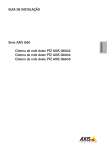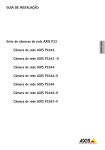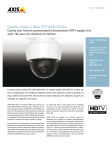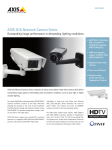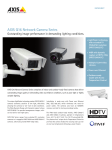Download AXIS P5532/P5534 Installation Guide
Transcript
INSTALLATION GUIDE www.stils.ru AXIS P5534 PTZ Dome Network Camera ENGLISH AXIS P5532 PTZ Dome Network Camera FRANÇAIS DEUTSCH ITALIANO ESPAÑOL Legal Considerations Video and audio surveillance can be prohibited by laws that vary from country to country. Check the laws in your local region before using this product for surveillance purposes. This product includes one (1) H.264 decoder license. To purchase further licenses, contact your reseller. Electromagnetic Compatibility (EMC) This equipment generates, uses and can radiate radio frequency energy and, if not installed and used in accordance with the instructions, may cause harmful interference to radio communications. However, there is no guarantee that interference will not occur in a particular installation. If this equipment does cause harmful interference to radio or television reception, which can be determined by turning the equipment off and on, the user is encouraged to try to correct the interference by one or more of the following measures: Re-orient or relocate the receiving antenna. Increase the separation between the equipment and receiver. Connect the equipment to an outlet on a different circuit to the receiver. Consult your dealer or an experienced radio/TV technician for help. Shielded (STP) network cables must be used with this unit to ensure compliance with EMC standards. USA - This equipment has been tested and found to comply with the limits for a Class B computing device pursuant to Subpart B of Part 15 of FCC rules, which are designed to provide reasonable protection against such interference when operated in a commercial environment. Operation of this equipment in a residential area is likely to cause interference, in which case the user at his/her own expense will be required to take whatever measures may be required to correct the interference. Canada - This Class B digital apparatus complies with Canadian ICES-003 Europe - This digital equipment fulfills the requirements for radiated emission according to limit B of EN55022, and the requirements for immunity according to EN55024 residential and commercial industry. Japan - This is a class B product based on the standard of the Voluntary Control Council for Interference from Information Technology Equipment (VCCI). If this is used near a radio or television receiver in a domestic environment, it may cause radio interference. Install and use the equipment according to the instruction manual. Australia - This electronic device meets the requirements of the Radio communications (Electromagnetic Compatibility) Standard AS/NZS CISPR22:2002. Korea - Class B: As this equipment has obtained EMC registration for household use, it can be used in any area including residential areas. Safety Complies to EN 60950-1 (IEC 60950-1), Safety of Information Technology Equipment. Equipment Modifications This equipment must be installed and used in strict accordance with the instructions given in the user documentation. This equipment contains no user-serviceable components. Unauthorized equipment changes or modifications will invalidate all applicable regulatory certifications and approvals. Liability Every care has been taken in the preparation of this document. Please inform your local Axis office of any inaccuracies or omissions. Axis Communications AB cannot be held responsible for any technical or typographical errors and reserves the right to make changes to the product and documentation without prior notice. Axis Communications AB makes no warranty of any kind with regard to the material contained within this document, including, but not limited to, the implied warranties of merchantability and fitness for a particular purpose. Axis Communications AB shall not be liable nor responsible for incidental or consequential damages in connection with the furnishing, performance or use of this material. RoHS This product complies with both the European RoHS directive, 2002/95/EC, and the Chinese RoHS regulations, ACPEIP. WEEE Directive The European Union has enacted a Directive 2002/96/EC on Waste Electrical and Electronic Equipment (WEEE Directive). This directive is applicable in the European Union member states. The WEEE marking on this product (see right) or its documentation indicates that the product must not be disposed of together with household waste. To prevent possible harm to human health and/or the environment, the product must be disposed of in an approved and environmentally safe recycling process. For further information on how to dispose of this product correctly, contact the product supplier, or the local authority responsible for waste disposal in your area. Business users should contact the product supplier for information on how to dispose of this product correctly. This product should not be mixed with other commercial waste. Support Should you require any technical assistance, please contact your Axis reseller. If your questions cannot be answered immediately, your reseller will forward your queries through the appropriate channels to ensure a rapid response. If you are connected to the Internet, you can: • download user documentation and firmware updates • find answers to resolved problems in the FAQ database. Search by product, category, or phrases • report problems to Axis support by logging in to your private support area. AXIS P5532/P5534 uses a 3.0V CR2032 Lithium battery, for more information please see page 111. AXIS P5532/P5534 Installation Guide Page 3 AXIS P5532 & AXIS P5534 Installation Guide This installation guide provides instructions for installing an AXIS P5532/AXIS P5534 PTZ Dome Network Camera on your network. For all other aspects of using the product, please see the User’s Manual, available on the CD included in this package, or from 1. Check the package contents against the list below. Important! 2. Hardware overview. See page 4. This product must be used in 3. Install the hardware. compliance with local laws and • Prepare for installation, see page 6. regulations. • Hard ceiling mount, see page 7. • Drop ceiling mount, see page 8. • Bracket mount (optional accessory), see page 10. • Install the AXIS T8123 High PoE Midspan 1-port, see page 11. 4. Assign an IP address. See page 12. 5. Set the password. See page 15. Package Contents Item Models/variants/notes Network camera AXIS P5532 AXIS P5534 Dome covers Clear transparent cover (pre-mounted) Smoked transparent cover Mounting kit Mounting kit for hard ceilings and drop ceilings Resitorx screw driver High PoE Midspan AXIS T8123 CD AXIS Network Video Product CD, including product documentation, installation tools and other software. Printed materials AXIS P5532/P5534 Network Camera Installation Guide (this document), Axis Warranty Document, Drill template, Extra serial number labels (2x), AVHS Authentication key Optional accessories AXIS T91A Mounting Accessories Multi-connector cable for connection of I/O, audio, and power ENGLISH Installation Steps Page 4 AXIS P5532/P5534 Installation Guide Hardware Overview Camera unit Control button SDHC card slot Status indicator LED Restart button Dome cover Dome ring screws (6) Dome ring Dome cover Top cover Sealing ring AXIS P5532/P5534 Installation Guide Page 5 Hard ceiling mount Mounting plate Bracket arm (3) Bracket arm screw (3) and washer (3) Trim ring Safety wire Unit holders (3) Camera base lid Camera base lid screws (4) Hook for safety wire Part number (P/N) & Serial number (S/N). The serial number may be required during the installation. Cable tracks Foam gasket Network connector Multi-connector Top cover screws (4) Top cover ENGLISH Mounting plate screws (3) Drop ceiling mount Page 6 AXIS P5532/P5534 Installation Guide Install the hardware ! IMPORTANT! - To use AXIS P5532/P5534 outdoors, it must be installed in an approved outdoor housing. Prepare for installation Read all the instructions before preparing to install AXIS P5532/P5534 since several installation preparation steps require removing the top cover and would benefit from being completed together. • • • Follow the instructions Remove the protective packaging, below to remove the protective packing before installing the camera. The camera is supplied with a clear transparent cover and a smoked transparent cover. If required, follow the instructions Replace the clear/smoked dome cover (optional), below to replace the dome cover. A standard or high capacity SD card (not included) is required to store images locally in the network camera. Follow the instructions Install an SD card (optional), below to remove the top cover and install an SD card. Remove the protective packaging 1. Loosen the 4 top cover screws and remove the top cover, see illustration on page 5. 2. Remove the protective packaging. Protective packaging 3. If replacing the clear/smoked dome cover or installing an SD card, refer to the instructions Replace the clear/smoked dome cover (optional) and Install an SD card (optional), below. 4. Put the top cover back in its original position and fasten the screws. AXIS P5532/P5534 Installation Guide Page 7 Replace the clear/smoked dome cover (optional) 1. Loosen the 4 top cover screws and remove the top cover, see illustration on page 5. 2. Remove the 6 dome ring screws and remove the dome ring from the top cover. 3. Attach the dome ring and the dome cover to the top cover and secure by tightening the 6 screws. 4. If installing an SD card, refer to the instructions Install an SD card (optional), below. 5. Put the top cover back in its original position and fasten the screws. Note: Install an SD card (optional) 1. Loosen the 4 top cover screws and remove the top cover, see illustration on page 5. 2. Insert an SD card (not included) into the SDHC (Secure Digital High Capacity) card slot. 3. Put the top cover back in its original position and fasten the screws. Note: The SD card is automatically mounted when inserted into the SDHC card slot. However, before removing the SD card it should be unmounted through the camera’s web pages. Go to Setup > System Options > Storage > SD Card and click Unmount. For more information, please see the User’s Manual available from the AXIS Network Video Product CD supplied with this product Hard ceiling mount 1. Prepare the ceiling for installation of the mounting plate, use the supplied drill template to position the holes. Make sure to use drill bits, screws, and plugs that are appropriate for the material. 2. Install the mounting plate. Mounting plate Security wire 3. Loosen the 4 camera base lid screws and remove the camera base lid, see illustration on page 5. ENGLISH Be careful not to scratch or damage the dome cover. Use a soft cloth to wipe clean before attaching the dome cover to the camera unit. Page 8 AXIS P5532/P5534 Installation Guide 4. Route and connect the network cable and the multi-connector cable, if applicable, to the network camera. Be careful not to damage the cables when connecting them. Make sure the foam gasket holes are aligned with the cable tracks and, if applicable, remove the cut-out piece for the multi-connector cable from the foam gasket. 5. Put the camera base lid back in its original position and fasten the screws. 6. Secure the camera using the supplied safety wire. 7. Slide the unit holders on the network camera into the slots on the mounting plate and rotate the camera unit. 8. Install the High PoE Midspan 1-Port, see Install the AXIS T8123 High PoE Midspan 1-port, on page 11. 9. Check that the indicator LEDs on the midspan indicate the correct conditions, see the table on page 21 for further details. Drop ceiling mount 1. Remove the ceiling tile in which the drop ceiling mount is to be fitted. 2. Use the supplied template to mark the position for the 210 mm (8.3 in.) hole in the ceiling tile. Cut around the template. Ceiling tile Hole diameter 210 mm (8.3 in.) Notes: • The combined weight of the camera and ceiling mount is approximately 2.3 kg (5.1 lb.). Check that the ceiling material is strong enough to support this weight. • The ceiling tile should be 5 mm–60 mm (0.2 in.–2.4 in.) thick. 3. 4. 5. 6. Assemble the ceiling bracket. Put the ceiling bracket into the ceiling tile, see illustration on page 9. Tighten the bracket arm screws using a torx 20 screwdriver head. Loosen the 4 camera base lid screws and remove the camera base lid, see illustration on page 5. AXIS P5532/P5534 Installation Guide Page 9 7. Route and connect the network cable and the multi-connector cable, if applicable, to the network camera. Be careful not to damage the cables when connecting them. Make sure the foam gasket holes are aligned with the cable tracks and, if applicable, remove the cut-out piece for the multi-connector cable from the foam gasket. Multi-connector cable 8. Put the camera base lid back in its original position and fasten the screws. 9. Secure the camera using the supplied safety wire. Ceiling bracket Safety wire Ceiling tile 10. Slide the unit holders on the network camera into the slots on the mounting plate and rotate the camera unit. 11. Install the High PoE Midspan 1-Port, see Install the AXIS T8123 High PoE Midspan 1-port, on page 11. 12. Check that the indicator LEDs on the midspan indicate the correct conditions. See the table on page 21 for further details. 13. Install the ceiling tile, with the camera mounted, into the ceiling. ENGLISH Network cable Page 10 AXIS P5532/P5534 Installation Guide 14. Place the trim ring over the ceiling bracket and snap it into place. Trim ring Bracket mount (optional accessory) 1. Install the selected bracket according to the instructions supplied with the bracket. If drilling is required, make sure to use drill bits, screws, and Torx T30 plugs that are appropriate for the material. Screws 2. Loosen the 4 camera base lid screws and remove the camera base lid, see illustration on page 5. 3. Route the network cable and the multi-connector Slots for Safety cable, if applicable, through the holes in the wire unit holders mounting bracket. Wall bracket (mounting example) 4. Hook the camera to the safety wire on the bracket. 5. Connect the network cable and, if applicable, the multi-connector cable to the network camera. 6. Install AXIS T8123, see Install the AXIS T8123 High PoE Midspan 1-port, on page 11. 7. Put the camera base lid back in its original position. 8. Slide the unit holders on the network camera into the slots on the bracket and rotate the camera unit. 9. Secure the network camera to the mounting bracket by fastening the 3 screws (Torx T30). AXIS P5532/P5534 Installation Guide Page 11 Install the AXIS T8123 High PoE Midspan 1-port AXIS T8123 High PoE Midspan 1-port enables Axis network video products with high power consumption to receive data and power over the same Ethernet cable. Follow these instructions to connect AXIS T8123. 1. Connect AXIS T8123 (Data in) to the network switch using a standard network cable. 2. Connect AXIS T8123 (Data and Power Out) to the network camera, using the network cable that has been connected to the camera. 3. Connect AXIS T8123 to an AC outlet (100–240 V AC), using the supplied power cable. Port Data & Power out Data in connectivity indicator AC Input connectivity indicator Network camera Ethernet For information on the LEDs on the midspan, see AXIS T8123 Status indicators, on page 21. ENGLISH AXIS T8123 Page 12 AXIS P5532/P5534 Installation Guide Assign an IP Address Most networks today have a DHCP server that automatically assigns IP addresses to connected devices. If your network does not have a DHCP server the network camera will use 192.168.0.90 as the default IP address. If you would like to assign a static IP address, the recommended method in Windows is either AXIS IP Utility or AXIS Camera Management. Depending on the number of cameras you wish to install, use the method that best suits your purpose. Both of these free applications are available on the AXIS Network Video Product CD supplied with this product, or they can be downloaded from Method Recommended for Operating system AXIS IP Utility See page 13 Single camera Small installations Windows AXIS Camera Management See page 14 Multiple cameras Large installations Installation on a different subnet Windows 2000 Windows XP Pro Windows 2003 Server Windows Vista Windows 7 Notes: • If assigning the IP address fails, check that there is no firewall blocking the operation. • For other methods of assigning or discovering the IP address, e.g. in other operating systems, see page 17. AXIS P5532/P5534 Installation Guide Page 13 AXIS IP Utility - single camera/small installation AXIS IP Utility automatically discovers and displays Axis devices on your network. The application can also be used to manually assign a static IP address. ENGLISH Note that the computer running AXIS IP Utility must be on the same network segment (physical subnet) as the network camera. Automatic discovery 1. 2. 3. 4. Check that the network camera is connected to the network and that power has been applied. Start AXIS IP Utility. When the camera appears in the window, double-click it to open its home page. See page 15 for instructions on how to assign the password. Assign the IP address manually (optional) 1. Acquire an unused IP address on the same network segment as your computer. 2. Select the network camera in the list. 3. Click the Assign new IP address to the selected device button and enter the IP address. 4. Click Assign and follow the on-screen instructions. Note that the camera must be restarted within 2 minutes for the new IP address to be set. 5. Click Home Page to access the camera’s web pages. 6. See page 15 for instructions on how to set the password. Page 14 AXIS P5532/P5534 Installation Guide AXIS Camera Management - multiple cameras/large installations AXIS Camera Management can automatically discover multiple Axis devices, show connection status, manage firmware upgrades and set IP addresses. Automatic discovery 1. Check that the camera is connected to the network and that power has been applied. 2. Start AXIS Camera Management. When the network camera appears in the window, right-click the link and select Live View Home Page. 3. See page 15 for instructions on how to set the password. Assign an IP address in a single device 1. Select the network camera in AXIS Camera Management and click the Assign IP button. 2. Select Assign the following IP address and enter the IP address, subnet mask and default router the device will use. 3. Click OK. Assign IP addresses in multiple devices AXIS Camera Management speeds up the process of assigning IP addresses to multiple devices, by suggesting IP addresses from a specified range. 1. Select the devices you wish to configure (different models can be selected) and click the Assign IP button. 2. Select Assign the following IP address range and enter the range of IP addresses, the subnet mask and default router the devices will use. 3. Click Update. Suggested IP addresses are listed under New IP Addresses and can be edited by selecting a device and clicking Edit. 4. Click OK. AXIS P5532/P5534 Installation Guide Page 15 Set the Password To gain access to the product, the password for the default administrator user root must be set. This is done in the ‘Configure Root Password’ dialog, which is displayed when the network camera is accessed for the first time. To prevent network eavesdropping when setting the root password, this can be done via an encrypted HTTPS connection, which requires an HTTPS certificate. To set the password via a standard HTTP connection, enter it directly in the first dialog shown below. To set the password via an encrypted HTTPS connection, follow these steps: 1. Click the Create self-signed certificate button. 2. Provide the requested information and click OK. The certificate is created and the password can now be set securely. All traffic to and from the network camera is encrypted from this point on. 3. Enter a password and then re-enter it to confirm the spelling. Click OK. The password has now been configured. To create an HTTPS connection, start by clicking this button. To configure the password directly via an unencrypted connection, enter the password here. 4. To log in, enter the user name “root” in the dialog as requested. Note: The default administrator user name root cannot be deleted. 5. Enter the password as set above, and click OK. Note: If the password is lost, the camera must be reset to the factory default settings. See page 22. ENGLISH Note: HTTPS (Hypertext Transfer Protocol over SSL) is a protocol used to encrypt the traffic between web browsers and servers. The HTTPS certificate controls the encrypted exchange of information. Page 16 AXIS P5532/P5534 Installation Guide Access the video stream The Live View page of the network camera is displayed, with links to the Setup tools, which allow you to customize the camera. If required, click Yes to install AMC (AXIS Media Control), which allows viewing of the video stream in Internet Explorer. You will need administrator rights on the computer to do this. If required, click the link to install missing decoders. Note: To install AMC in Windows 7/Windows Vista, you must run Internet Explorer as an administrator. Right-click the Internet Explorer icon and select Run as administrator. Setup - Provides all the tools for configuring the camera to requirements. Help - Displays online help on all aspects of using the camera. AXIS P5532/P5534 Installation Guide Page 17 Other Methods of Setting the IP address The table below shows the other methods available for setting or discovering the IP address. All methods are enabled by default, and all can be disabled. Use in operating Notes system All To connect the camera to an AVHS service, refer to the service provider´s Installation Guide. For information and help to find a local AVHS Service Provider go to UPnP™ Windows When enabled on your computer, the camera is automatically detected and added to “My Network Places.” Bonjour MAC OSX (10.4 or later) Applicable to browsers with support for Bonjour. Navigate to the Bonjour bookmark in your browser (e.g. Safari) and click on the link to access the camera’s web pages. AXIS Dynamic DNS Service All A free service from Axis that allows you to quickly and simply install your camera. Requires an Internet connection with no HTTP proxy. See ARP/Ping All See below. The command must be issued within 2 minutes of connecting power to the camera. DHCP All To view the admin pages for the network DHCP server, see the server’s own documentation. ENGLISH AVHS Service Connection Page 18 AXIS P5532/P5534 Installation Guide Set the IP address with ARP/Ping 1. Acquire an IP address on the same network segment your computer is connected to. 2. Locate the serial number (S/N) on the product label on the camera. 3. Open a command prompt on your computer and enter the following commands: Windows syntax: Windows example: arp -s <IP Address> <Serial Number> ping -l 408 -t <IP Address> arp -s 192.168.0.125 00-40-8c-18-10-00 ping -l 408 -t 192.168.0.125 UNIX/Linux/Mac syntax: UNIX/Linux/Mac example: arp -s <IP Address> <Serial Number> temp ping -s 408 <IP Address> arp -s 192.168.0.125 00:40:8c:18:10:00 temp ping -s 408 192.168.0.125 4. Check that the network cable is connected to the camera and then start/restart the camera, by disconnecting and reconnecting power. 5. Close the command prompt when you see ‘Reply from 192.168.0.125: ...’ or similar. 6. In your browser, type in http://<IP address> in the Location/Address field and press Enter on your keyboard. Notes: • To open a command prompt in Windows: from the Start menu, select Run... and type cmd. Click OK. • To use the ARP command in Windows 7/ Windows Vista, right-click the command prompt icon and select Run as administrator. • To use the ARP command on a Mac OS X, use the Terminal utility in Application > Utilities. AXIS P5532/P5534 Installation Guide Page 19 Unit Connectors Network connector – RJ-45 Ethernet connector. Supports High PoE (Power over Ethernet, IEEE 802.3at). Use AXIS T8123 High PoE Midspan 1-port (included). Shielded cables should be used to comply with EMC. SDHC card slot – A standard or high capacity SD card (not included) is required to store images locally in the network camera. To insert and remove the SD card, the camera’s top cover must be removed, see Install an SD card (optional), on page 7. Note: Before removal, the SD card should be unmounted to prevent corruption of recordings. To unmount the SD card, go to Setup > System Options > Storage > SD Card and click Unmount. For more information, please see the User’s Manual available from the AXIS Network Video Product CD supplied with this product or from the website at . ENGLISH Multi-connector – Terminal connector for connection of external equipment: • Audio equipment • Input/output (I/O) devices • AC/DC power supply When connecting external equipment to AXIS P5532/P5534, a multi-connector cable is required in order to maintain the IP51 rating. The multi-connector cable can be purchased from your Axis reseller. For more information, please see the User’s Manual available from the AXIS Network Video Product CD supplied with this product or from the website at . Page 20 AXIS P5532/P5534 Installation Guide Multi-connector cable (not included) When connecting external equipment to AXIS P5532/P5534, a multi-connector cable is required in order to maintain the camera’s IP51 rating. The multi-connector cable can be purchased from your Axis reseller. Connect the multi-connector cable to the camera’s multi connector, see illustration on page 5 and instructions on page 7 and page 8. The cable provides the following connectors: Power connector – 3-pin terminal block used for power input. DC power input, 24-34 V DC AXIS P5532: max 15 W AXIS P5534: max 17 W AC power input, 20-24 V AC AXIS P5532: max 20 VA AXIS P5534: max 23.6 VA Audio in (pink) – 3.5 mm input for a mono microphone, or a line-in mono signal (left channel is used from a stereo signal). Audio out (green) – 3.5 mm output for audio (line level) that can be connected to a public address (PA) system or an active speaker with a built-in amplifier. A pair of headphones can also be attached. A stereo connector must be used for the audio out. I/O terminal connector – Used in applications for e.g. motion detection, event triggering, time lapse recording and alarm notifications. In addition to an auxiliary power and a GND pin, the I/O terminal connector has 4 pins that can be configured as either input or output. These pins provide the interface to: • Digital output - For connecting external devices such as relays and LEDs. Connected devices can be activated by the VAPIX® Application Programming Interface, output buttons on the Live View page or by an Event Type. The output will show as active (shown under Events > Port Status if the alarm device is activated. AXIS P5532/P5534 Installation Guide • Page 21 Digital input - An alarm input for connecting devices that can toggle between an open and closed circuit, for example: PIRs, door/window contacts, glass break detectors, etc. When a signal is received the state changes and the input becomes active (shown under Events > Port Status). Function Pin Notes Specifications GND 1 Ground 3.3 V DC Power 2 Can be used to power auxiliary equipment. Note: This pin can only be used as power out. Configurable (input or Output) 3-6 Digital input – Connect to GND to activate, or leave floating Min. input = -40 V DC (unconnected) to deactivate. Max. input = +40 V DC Max. load = 250 mA AXIS P5532/P5534 Status indicators Color Indication Unlit Steady connection/normal operation Amber Steady during system initiating and reset to factory default. Flashes during firmware upgrade. Amber/red No network connection Red Firmware upgrade failure Green Steady for 10 sec. after successful restart Note: For more information on the AXIS P5532/P5534 status indicators, please see the User’s Manual available from the AXIS Network Video Product CD supplied with this product or from the website at . AXIS T8123 Status indicators LED Port AC input Color Indication Unlit No camera connected Flashing Power overload or other input voltage error Green Camera connected, normal behavior Steady green AC power connected ENGLISH Digital output – Uses an open-drain NFET transistor with the Max. load = 100 mA source connected to GND. If used with an external relay, a Max. voltage = +40 V DC diode must be connected in parallel with the load, for protection against voltage transients. Page 22 AXIS P5532/P5534 Installation Guide Resetting to the Factory Default Settings To reset the camera to the original factory default settings, use the control button and the restart button on the side of the camera, see Hardware Overview, on page 4, as described below: Using the control and restart buttons will reset all the parameters, including the IP address, to the factory default settings: 1. 2. 3. 4. Remove the top cover, see Remove the protective packaging, on page 6. Press and hold the control button and the restart button at the same time. Release the restart button but continue to hold down the control button. Continue to hold down the control button until the status indicator color changes to amber (this may take up to 15 seconds). 5. Release the control button. 6. When the status indicator changes to green (which may take up to 1 minute), the process is complete and the camera has been reset. The unit now has the default IP address 192.168.0.90 7. Put the top cover back in its original position. 8. Re-assign the IP address, using one of the methods described in Assign an IP Address, on page 12. It is also possible to reset parameters to the original factory default settings via the web interface. For more information, please see the online help or the User’s Manual available from the AXIS Network Video Product CD supplied with this product. Accessing the Camera from the Internet Once installed, your network camera is accessible on your local network (LAN). To access the camera from the Internet, network routers must be configured to allow incoming traffic, which is usually done on a specific port. • HTTP port (default port 80) for viewing and configuration • RTSP port (default port 554) for viewing H.264 video streams Please refer to the documentation for your router for further instructions. For more information on this and other topics, visit the Axis Support Web at ./techsup Further Information The User’s Manual is available from the Axis Web site at . or from the AXIS Network Video Product CD supplied with this product. Tip! Visit ./techsup to check if there is updated firmware available for your network camera. To see the currently installed firmware version, see Setup > About. www.stils.ru
























